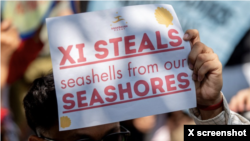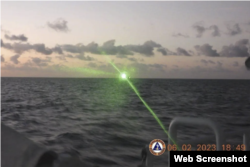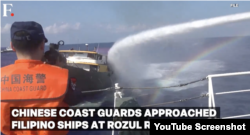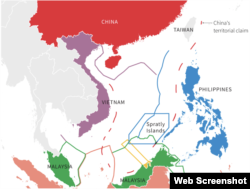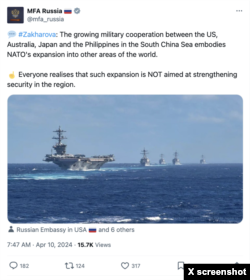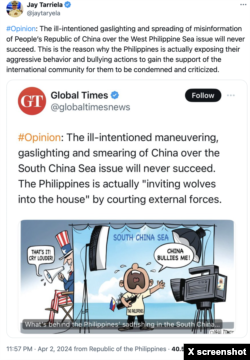At the Chinese Foreign Ministry’s regular news conference on April 3, spokesperson Wang Wenbin commented on rising tensions between the Philippines and China, saying:
“The Philippines keeps accusing China of ‘intimidating smaller countries’ without mentioning at all the Philippine occupation and encroachment on China’s territory in Nansha Qundao. That is a real propaganda ‘trap.’ The Ren’ai Jiao issue is not a case of the big bullying small but unfulfilled promises and deliberate provocations …”
The comment came amid growing tension between China and the Philippines in the South China Sea.
He added, “The Philippines has been pursuing selfish gains at the expense of the consensus reached by countries in the region. This is the main reason why the situation in the South China Sea has escalated and become more complicated.”
That is false.
First, it is worth noting the instances documented by the Philippine coast guard and independent media of China’s gray zone activities and aggressive actions toward Philippine vessels. For instance, on April 4, Jay Tarriela, spokesperson of the Philippine coast guard, reported that China’s coast guard used water cannons to threaten two Filipino fishing ships. China has also used collision and ramming tactics, undersea barriers and a military-grade laser to stop Philippine resupply and patrol missions.
In addition, there is no official “promise” between the Philippines and China. China has alluded to a supposed gentleman’s agreement established between China and former Philippine President Rodrigo Duterte.
Current Philippine President Ferdinand Marcos Jr. noted that he was not made aware of such an agreement — it was never written down — and he was “horrified by the idea …”
He also issued a statement: “Let us not fall into the trap set by Chinese propaganda of refocusing the debate on a so-called promise, while deflecting attention away from China’s government, thereby freeing and allowing them to continue with their illegal activities.”
The deal was semicorroborated by former Philippine presidential spokesperson Harry Roque and further clarified by Duterte himself on April 12. Duterte has stated the agreement was to maintain the “status quo” in the South China Sea but not to limit the Philippines’ sovereignty. Roque similarly noted that the “status quo” did not mean ceding the Philippines’ claims to territory such as the Second Thomas Shoal, which China calls Ren’ai Jiao.
The Second Thomas Shoal has been long disputed. In 1999, the Philippines purposefully grounded its naval ship BRP Sierra Madre to affirm that the shoal was Filipino territory. Filipino soldiers still live on Sierra Madre, and tensions have risen over China blocking their resupply missions.
Finally, China’s claims to the South China Sea are neither internationally recognized nor recognized by many ASEAN countries.
China’s territorial claims, marked on the nine-dash line, extend to about 90% of the South China Sea, violating many of its neighbors’ claims to sovereignty, including the Philippines’ exclusive economic zone.
Even more, the sovereignty claims made by China’s Foreign Ministry spokesperson openly ignore international law. In 2016, the Philippines brought a case before the Permanent Court of Arbitration, or PCA, at The Hague, Netherlands, over China’s territorial claims in the South China Sea. The court ruled that China’s territorial claims were groundless, with no legal foundation. It further ruled that Second Thomas Shoal lies within the Philippines’ exclusive economic zone.
Yet, China continues to ignore the ruling.
Furthermore, China’s claims — that the Philippines stoked tensions by bringing in other actors — are also false. The Philippines became closer with the U.S. after a rise in gray zone activities by China.
The United States has also tried to engage in a dialogue with China. On April 2, U.S. President Joseph Biden called Chinese President Xi Jinping to express concerns over rising tensions and even reportedly discussed visits by the U.S. secretary of state and treasury secretary to China.
Despite Biden’s call, China launched a People’s Liberation Army, or PLA, patrol the same day the Philippines, U.S., Japan and Australia held a joint maritime exercise.
Notably, the Russian Foreign Ministry attempted to capitalize on this situation with false claims that the current dispute is the fault of Western “expansion.”
The U.S. and the Philippines have had a mutual defense agreement since 1951, so their current joint actions are simply an affirmation of that agreement.
On April 11, Biden affirmed U.S. support, stating, “Any attack on Philippine aircraft, vessels or armed forces in the South China Sea would invoke our mutual defense treaty.”
Chinese and Russian attempts to blame the West fail to recognize the right of countries such as the Philippines to have their own security and foreign policy and to strengthen alliances with other countries, including the United States.
